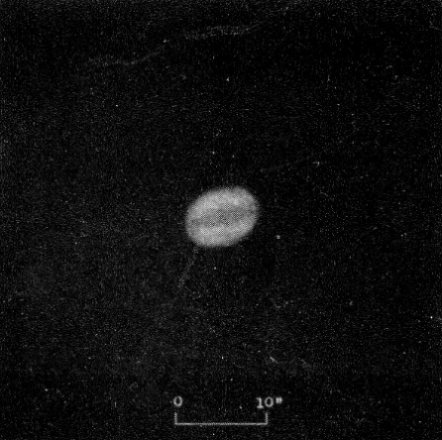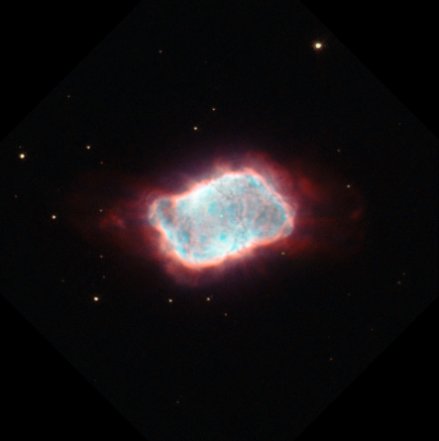NGC 6741
The central stars of planetary
nebulae span a huge range of temperature, within which NGC 6741
is, at 180,000 Kelvin, one of the hotter (one study taking it to
220,000), comparable to NGC 2440 and NGC 7027. The nebula, just 8
seconds of arc across, is small, rendering it hard to discern
features, as witness Curtis's drawing. He says of it: "No central
star...small bright oval...indistinct ring structure...scarcely
perceptible protuberance at the western end." Hubble dramatically
expands on this description by showing an interior filled with
threads of hot gas (with a high temperature approaching 18,000
Kelvin, much higher than the average of 10,000 K) that terminates
in a sharp boundary with no visible outer shell, the central star
remaining invisible. NGC 6741 goes also goes by the odd popular
name (not much used) of the "Phantom Streak Nebula."
Located within the Milky Way in southwestern
Aquila (not quite five degrees north of
Lambda Aquilae), the distance is
best estimated through its two or so magnitudes of light-absorption
by interstellar dust, which gives a range between 4900 and 8700
light years, which in turn gives a range in diameter for the object
of two-tenths to a third of a light year.
While the central star is not seen here, it has been detected at
magnitude 20.0, and thus is easily lost within the bright
nebulosity, its high temperature causing it to glow mostly in the
far ultraviolet part of the spectrum where we cannot see it. The
stellar luminosity, which depends on distance, is hard to
constrain, but is probably of the order of 1000 Suns, perhaps a bit greater. The star has
apparently recently hit maximum temperature for a roughly-0.6 or so
solar mass core and has begun to cool. As the nebula expands at 22
kilometers per second, the star's radiation will shift ever-more
toward the visual, eventually rendering it visible to the eye
within a larger, fainter nebula. NGC 6741 appears rich in helium,
while (unlike NGC 2440 and 7027) normal in carbon content, and
confused in nitrogen (for which enrichment is unclear).
Left: Image by H. D. Curtis from Publications of the Lick
Observatory, Volume 13, Part III, 1918. Right: ESA/Hubble and
NASA.



